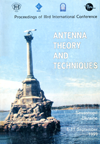Optimization of characteristics of directivity of horn microwave band radiators
DOI:
https://doi.org/10.1109/ICATT.1999.1236200Abstract
There have been several stages in development of the horn antennae (HA). The initial period was characterized by employing straight HA. The antennae of this type are still used nowadays. They were followed by stepped-shape horns. Another type of horn was that with corrugated walls. As compared with similar flat-wall antennae these horns should be preferred for being able to provide symmetrical circular space patterns and practically stable main-lobe width even when the operating frequency changes two-fold. Also, their beam patterns practically do not have back or side lobes. And, finally, at the next stage, the employment of horns of curved configuration came into practice.References
Kinber, B.E. On Diffraction of Electromagnetic Waves on Concave Surface of Circular Cylinder. Radioengineering and Electronics, 1961, Vol. 6.
Russo, P.M.; Rudduck, R.C.; Peters, L.J. A Method for Computing E-Plane Patterns of horn Antennas. IEEE Trans. Antennas and Propagation, 1965, No. 3, P. 219-225.
Shumlyanskiy, I.I. Horn Radiators of Complex Configuration. Singapore-London: World Scientific, 1993, 172 p.
Shumlyanskiy, I.I. Horn Radiators with Stepped and Curved Generants. Kiev: Vysha Skola, 1986, 147 p. [in Russian].
Published
1999-09-14
Issue
Section
LGA, printed antennas

